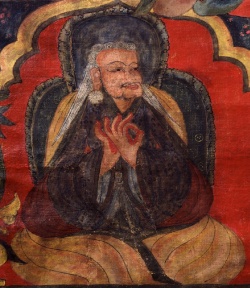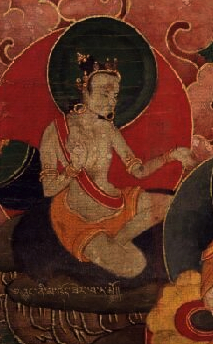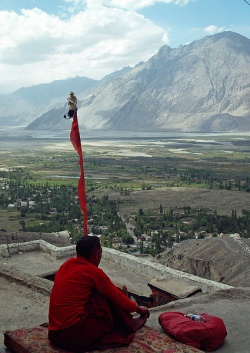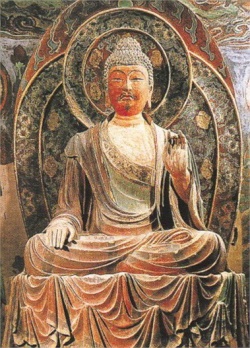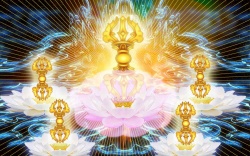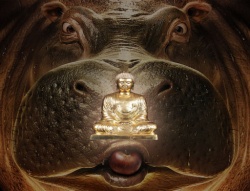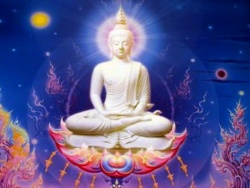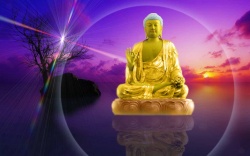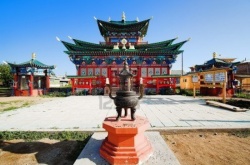Nyangrel Nyima Ozer
Nyangrel Nyima Ozer; ཉང་རལ་ཉི་མ་འོད་ཟེར།;
Ngadak Nyangrel Nyima Ozer (mnga' bdag nyang/myang ral nyi ma 'od zer) was born in 1124 (an alternate date of 1136 has occasionally been suggested in western sources, but is almost certainly mistaken) in Lhodrak.
His father was Nyangton Chokyi Khorlo (nyang/myang ston chos kyi 'khor lo, d. ca. 1142), who traced his ancestry back to at least the eighth century when members of the Nyang clan populated the inner circles of several emperors.
A lay tantrika who claimed to maintain his family's tantric transmission lineage under his secret initiatory name of Dorje Wangchuk Tsel (rdo rje dbang phyug rtsal), he appears to have gathered a small retinue of disciples to the south of Tibet's first monastery, Samye (bsam yas).
Nyangrel's mother was named Jomo Yeshe Dron (jo mo ye shes gron), and her initiatory name was either Pema Dechen Tsel (padma bde chen rtsal) or Pema Dewa Tsel (padma bde ba rtsal), the latter being a variant of an epithet of Hayagrīva (rta mgrin),
the fierce deity of the Padma buddha family who would become the focus of Nyangrel's meditation throughout his younger years.
Ostensibly due to the presence of multiple auspicious marks on the infant's body, his parents are said to have kept him out of the public eye, maintaining a retreat where they trained him privately in letters and meditation.
Having learned to read at a very young age, he showed an uncanny propensity to memorize the various tantras and sādhanas that formed the basis of the [[Nyang clan's]practice lineages]].
Whether he was concealed in retreat because of his appearance or ostracized for his own predilections towards Buddhism, his childhood was one of isolation; there is no record of him having any siblings.
According to the hagiographies, he experienced numerous auspicious dreams and visions from the age of seven whereby various magical emanations -- Padmasambhava among them -- confirmed his identity and his destiny as a future treasure revealer.
His father then gave him a series of empowerments, most importantly that of his life-long tutelary deity, Hayagrīva.
Throughout his teenage years Nyangrel engaged in formal practice and is said to have attained various signs of accomplishment.
It was during these early retreats that he is said to have first remembered his past lives, a line that, he maintained, began with the eighth-century emperor Tri Songdetsen (khri srong lde btsan, c.742-800), who had invited Padmasambhava to Tibet, and continued in an unbroken sequence of sixteen reincarnations.
His primary biographies include a number of first-person recollections of his life as the emperor, and it is important to note that Nyangrel's claim to a concatenated sequence of past lives preceded the institutionalized reincarnation lines such as the Karmapa.
Having received the transmissions of his clan during his childhood and mastered them throughout his adolescence, Nyangrel ventured out from his homeland toward the end of his teenage years, perhaps due to the passing of his father around that time.
He went on to receive transmissions from a number of gurus.
From Lobpon Chokyi Drakpa (slob dpon chos kyi grags pa, d.u.) and Chokyi Dorje (chos kyi rdo rje, d.u.) he received the foundational scriptures of what would soon come to be known as the Nyingma tradition, such as the Māyājāla tantra, the Sūtra Gathering the Intent (dgongs pa 'dus pa'i mdo), and the Mental class (sems sde) of Dzogchen (rdzogs chen).
Nyangrel also studied the traditions that had been brought to Tibet by Padampa Sanggye (pha dam pa sangs rgyas, d. c.1117): he received Cho from Lama Dzongpa (bla ma rdzong pa, d.u.)
and the three lines of Zhije transmission, Ma, So and Kam (rma, so, kaṃ/skam) from Lama Chupa Dartonpa (bla ma 'chus pa dar ston pa, c. 1117-1192), Mel Kawachenpa (mal ka ba can pa, c. 1126-1211) and Nyonpa Donden (smyon pa don ldan, d.u.).
Two of Nyangrel's most consequential gurus were the treasure revealers Lama Rashak (bla ma ra shag, d.u.) and Drubtob Ngodrub (grub thob dngos grub, d.u.),
who not only bestowed empowerments for cycles that they had found as treasure, but furnished the young adept with certificates that led him to find his own treasures as well.
Nyangrel constructed a small hermitage at a relatively desolate place known as Mawochok (smra bo lcogs) in Lhodrak.
He was impoverished at this time and in need of support for his retreat practice, which he sought through the performance of thread-crosses (mdos) and other rites as a tantrika for hire.
According to his hagiographies, Nyangrel remained in the region despite its challenges due to several encounters with magical emanations, all of which reiterated that the site was indeed sacred ground.
Eventually Nyangrel met a young yogin who imparted upon him treasure site certificates, before departing mysteriously.
Concluding that the yogin was an emanation of Padmasambhava, Nyangrel understood the documents to refer to a nearby place called Drak Sinmobarje (brak srin mo sbar rje), a large rock formation just down the river from his hermitage.
There he recovered his first major treasure cache from within a hidden cave that is attested to have been the gathering hall of Padmasambhava himself, his throne and implements still resting in situ at the center, with a number of caches concealed in the ground around them.
This is where Nyangrel found several of his most important cycles, such as The Great Compassionate One (thugs rje chen po) that came to be known as the Maṇi Kambum (ma ṇi bka' 'bum).
This collection includes foundation narratives for the national myths that established Avalokiteśvara as the [[patron bodhisattva of Tibet]], promoting the cult of Avalokiteśvara and the practice of the six-syllable mantra oṃ maṇi padme hūṃ.
At Drak Sinmobarje he also found cycles on The Secret Ḍākinī (mkha' 'gro gsang ba) and one on Padmasambhava known as Guru Vidyādhara (bla ma rig 'dzin).
Nyangrel revealed solely material treasure texts and relics from several sites, many of which were renowned locations of imperial pedigree no more than a few days journey from Mawochok.
Among these sites were the massive Vairocana statue in Khoting Lhakhang ('kho 'thing lha khang), a border-taming temple built by the Tibetan emperor Songtsen Gampo (srong btsan sgam po, r. 617-650), from which Nyangrel recovered TheEight Instructions: Assembly of the Ones Gone to Bliss (bka' brgyad bde gshegs 'dus pa) on fierce deity yoga.
Another biography states that rather than recovering this cycle alone at Khoting, Nyangrel simply received it from Lama Rashak) as a set of seven small volumes.
His cycle subsequently inspired the revelation of new iterations of The Eight Instructions by later treasure revealers such as Guru Chowang (gu ru chos dbang, 1212-1270), Rigdzin Godemchen (rig 'dzin rgod ldem can, 1337-1408), and
Terdak Lingpa Gyurme Dorje (gter bdag gling pa 'gyur med rdo rje, 1646-1714).
He also found an uncommon categorization of Dzogchen instructions, divided hierarchically as Transcendent Pith (a ti), Ultra Pith (yang ti) and Crown Pith (spyi ti) at Samye Monastery.
Nyangrel remains best known for revealing The Copper Palace (bka' thang zangs gling ma), the first complete hagiography of Padmasambhava.
The text introduced one of the foundational narratives of Tibet's eighth-century conversion, greatly expanding the role of Padmasambhava and transforming him into a buddha responsible for the establishment of Buddhism in Tibet.
Much of this narrative was incorporated into the history of Buddhism entitled Flower Nectar:
The Essence of Honey (chos 'byung me tog snying po sbrang rtsi'i bcud), which is also attributed to Nyangrel.
This history places Nyangrel's Padmasambhava narrative at center such that it deliberately excludes earlier accounts that contradict it.
In addition to textual treasures, Nyangrel recovered a diverse array of consecrated, magical and/or medicinal substances; ritual implements for meditation and thaumaturgy; weapons and statues.
Over the course of his extensive treasure activity, Nyangrel attracted a large number of students and patrons who provided the means for him to develop Mawochok into a more significant temple, hermitage, and residence.
Having concluding the majority of his treasure revelations in his forties or fifties, Nyangrel settled at Mawochok with his wife, Jobuma (jo bum ma), whom he presented as an emanation of Padmasambhava's legendary consort,
Yeshe Tsogyel (ye shes mtsho rgyal) and their two sons, Namkha Ozer (nam mkha' 'od zer, d.u.) and Namkha Pel (nam mkha' dpal, c. 1164/1176-1236).
To his sons he transmitted both his family lineage and that of his treasure revelations.
Much of this later period was spent in meditative retreat, though it seems he rarely remained in extended seclusion.
In 1192 at the age of sixty-nine, Nyangrel selected four or five primary disciples to continue specific transmissions: Nyangton Drakpa Gyeltsen (myang ston grags pa rgyal mtshan, d.u.) received The Eight Instructions;
Zhikpo Dutsi (zhig po bdud rtsi, 1149-1199) received emperor Songtsen Gampo's tradition of The Great Compassionate One; Jemon Onpa (rje smon 'on pa, d.u.) received Padmasambhava's tradition of The Great Compassionate One;
and Mikyo Dorje (mi bskyod rdo rje, d.u.) received The Secret Ḍākinī.
His second son, Namkha Pel, was identified as his primary spiritual and material heir.
He bestowed his final testaments and instructions, and declared that it was time for him to ascend to Dewachen (bde ba can), Amitābha's pure realm.
After he passed away his body was cremated, and the remains were placed in a massive reliquary that survives at the Mawochok hermitage.
(An alternate year of his death, 1204, is a lingering discrepancy repudiated in part by the fact that one of his primary heirs, Zhigpo Dutsi, could not have died before him.)
Name Variants:
Ngadak Nyang;
Ngadak Nyang Relpachen Nyima Ozer;
Ngadak Nyangrel Nyima Ozer;
Nyang Nyima Ozer;
Nyangrel;
Nyima Ozer
Daniel Hirshberg is a Faculty Fellow in Tibetan Studies at the University of California.
Published April 2013
Source
http://treasuryoflives.org/biographies/view/Nyangrel-Nyima-Ozer/5999
